The exotic and invasive flora of Portugal - Universidade de Coimbra
The exotic and invasive flora of Portugal - Universidade de Coimbra
The exotic and invasive flora of Portugal - Universidade de Coimbra
Create successful ePaper yourself
Turn your PDF publications into a flip-book with our unique Google optimized e-Paper software.
Botanica Complutensis ISSN: 0214-4565<br />
2001,25,317-327<br />
<strong>The</strong> <strong>exotic</strong> <strong>and</strong> <strong>invasive</strong> <strong>flora</strong><br />
<strong>of</strong> <strong>Portugal</strong><br />
João DOMINGUES DE ALMEIDA & Helena FREITAS<br />
Departamento <strong>de</strong> Botânica, <strong>Universida<strong>de</strong></strong> <strong>de</strong> <strong>Coimbra</strong>,<br />
3049 <strong>Coimbra</strong>; <strong>Portugal</strong>. e-mail: hfreitas@ci,uc.pt<br />
Abstract<br />
ALMEillA, I.D. & FREITAS, H. 2001. <strong>The</strong> <strong>exotic</strong> <strong>and</strong> <strong>invasive</strong> <strong>flora</strong> <strong>of</strong><strong>Portugal</strong>. Bot. Complutensis<br />
25: 317-327.<br />
<strong>The</strong> presence <strong>of</strong> <strong>exotic</strong> plants in <strong>Portugal</strong> has increased during the last two centuries.<br />
Aliens represent today more than 15 % <strong>of</strong> the Portuguese <strong>flora</strong>. We present a report <strong>of</strong> the<br />
<strong>exotic</strong> <strong>flora</strong> <strong>of</strong> <strong>Portugal</strong>, based on available bibliography, herbarium specimens <strong>and</strong> field surveys<br />
We have used the Country's traditional division in eleven provinces, <strong>and</strong> the species<br />
geographical distribution is given accordingly, since this is the usual taxonomical methodology.<br />
<strong>The</strong> progression <strong>of</strong> alien plants by families along time <strong>and</strong> some ecological characteristics<br />
are also discussed.<br />
Keywords: Flora, <strong>exotic</strong> species, <strong>Portugal</strong>.<br />
Resumen<br />
ALMEIDA, I.D. & FREITAS, H. 2001. La <strong>flora</strong> exótica e invasora <strong>de</strong> <strong>Portugal</strong>. Bot. Complutensis<br />
25: 317-327.<br />
La presencia <strong>de</strong> plantas exóticas en <strong>Portugal</strong> se viene increment<strong>and</strong>o en los dos últimos<br />
siglos. Las plantas exóticas representan hoy más <strong>de</strong> 15 % <strong>de</strong> Ia <strong>flora</strong> portuguesa. Presentamos<br />
un relatorio <strong>de</strong> Ia situación actual <strong>de</strong> Ia <strong>flora</strong> exótica <strong>de</strong> <strong>Portugal</strong> basado en Ia bibliografía<br />
disponible, pliegos <strong>de</strong> herbario y prospecciones en el campo. Utilizamos Ia división<br />
tradicional <strong>de</strong> <strong>Portugal</strong> en once provincias para indicar Ia distribución geográfica <strong>de</strong> Ias especies,<br />
<strong>de</strong> acuerdo con Ia metodología taxonómica usual. La progresión <strong>de</strong> Ias especies exóticas<br />
por famílias durante el tiempo y algunas características ecológicas son también discutidas.<br />
Palabras-clave: Flora, especies exóticas, <strong>Portugal</strong>.<br />
Resumo<br />
ALMEIDA, I.D. & FREITAS, H. 2001. A <strong>flora</strong> exótica e invasora <strong>de</strong> <strong>Portugal</strong>. Bot. Complutensis<br />
25: 317-327,
J. Domingues <strong>de</strong> Almeida & H. Freitas <strong>The</strong> <strong>exotic</strong> <strong>and</strong> <strong>invasive</strong> <strong>flora</strong> <strong>of</strong> <strong>Portugal</strong><br />
A presença <strong>de</strong> plantas exóticas em <strong>Portugal</strong> tem-se vindo a incrementar nos dois últimos<br />
séculos. As plantas exóticas representam hoje mais <strong>de</strong> 15 % da <strong>flora</strong> portuguesa. Apresentamos<br />
um relatório da situação actual da <strong>flora</strong> exótica <strong>de</strong> <strong>Portugal</strong> baseado na bibliografia<br />
disponível, exemplares <strong>de</strong> herbário e prospecções no campo. Utilizamos a divisão tradicional<br />
<strong>de</strong> <strong>Portugal</strong> em onze províncias para indicar a distribuição geográfica das espécies, <strong>de</strong><br />
acordo com a metodologia taxonómica usual. A progressão das espécies exóticas por famílias<br />
ao longo do tempo e algumas características ecológicas também são discutidas.<br />
Palavras-chave: Flora, espécies exóticas, <strong>Portugal</strong>.<br />
Botanica Comp1utensis<br />
2001,25,317-327<br />
INTRODUCTION<br />
<strong>The</strong> expansion <strong>of</strong> <strong>exotic</strong> <strong>invasive</strong> plants is threatening the Portuguese native <strong>flora</strong><br />
<strong>and</strong> is becoming a severe environmental prob1em. This work will give a brief<br />
historical background <strong>and</strong> an overview <strong>of</strong> the present situation.<br />
Subspontaneous plants are introduced plants effectively natura1ised (Franco<br />
1971), adapted to the ecological conditions <strong>of</strong> our Country. Subspontaneous plants<br />
were almost all introduced by man, although their success doesn't require human<br />
intervention, since they reproduce <strong>and</strong> spread spontaneously. <strong>The</strong>y present advantages<br />
relatively to the majority <strong>of</strong> our native plants, for example, the absence <strong>of</strong><br />
their natural enemies <strong>and</strong> a greater environmental resistance or a faster growth.<br />
<strong>The</strong>y overtake our native plants in competition, tending to replace them. This replacement<br />
can be partial or total, <strong>de</strong>pending on the propagating capacities <strong>of</strong> the <strong>invasive</strong><br />
plants, <strong>and</strong> the more or less effective isolation <strong>of</strong> the populations <strong>of</strong> our<br />
indigenous species. We can classify introduced plants according to their characteristics,<br />
geographic provenience, the aim for introduction or by their <strong>de</strong>gree <strong>of</strong> threat for<br />
the native <strong>flora</strong>.<br />
Human intervention is not necessary for the reproduction <strong>and</strong> expansion <strong>of</strong> <strong>invasive</strong><br />
species, as these plants can propagate themselves efficiently by their own<br />
means. Man, however, usually enhances spread <strong>of</strong> <strong>invasive</strong> alien plants, creating<br />
ru<strong>de</strong>ral habitats which are favourable to the large majority <strong>of</strong> them. For example,<br />
the construction <strong>of</strong> roads <strong>and</strong> railways constitutes a precious help to the<br />
expansion <strong>of</strong> synanthropic plants.<br />
Colmeiro (1891) quoted, for the whole lberian Peninsula, 111 introduced plant<br />
species for a total number <strong>of</strong> 6145 species <strong>of</strong> vascu1ar plants (6064 species <strong>of</strong><br />
phanerogamics <strong>and</strong> 81 species <strong>of</strong> vascular cryptogamics).In1890, non-indigenous<br />
plants represented 1.8 % <strong>of</strong> the total number <strong>of</strong> species <strong>of</strong> the lberian <strong>flora</strong>.<br />
Pereira Continho (1920) consi<strong>de</strong>red 2696 species in the Portuguese <strong>flora</strong>, including<br />
142 species frequently cultivated <strong>and</strong> 97 subspontaneous. Thus, in 1920,<br />
naturalised introduced species represented 3.6 % <strong>of</strong> the total number <strong>of</strong> species<br />
<strong>of</strong> the Portuguese <strong>flora</strong>; twice the number that Colmeiro (1891) referred thirty<br />
years before for the lberian Peninsula.<br />
In 1939,2853 species <strong>of</strong> vascular p1ants were known in continental <strong>Portugal</strong>.<br />
From these, 211 (7.4%) could have been consi<strong>de</strong>red subspontaneous (Pinto da<br />
318
J. Domingues <strong>de</strong> Almeida & H. Freitas <strong>The</strong> <strong>exotic</strong> <strong>and</strong> <strong>invasive</strong> <strong>flora</strong> <strong>of</strong> <strong>Portugal</strong><br />
Silva 1971). Fem<strong>and</strong>es (1955) reported 33 new cases <strong>of</strong> subspontaneity <strong>de</strong>tected<br />
between 1939 <strong>and</strong> 1954. Between 1955 <strong>and</strong> 1961, 41 new species were<br />
introduced in <strong>Portugal</strong>, therefore exceeding the 35 new introductions which had<br />
been <strong>de</strong>tected during the preceding fifteen years (Pinto da Silva 1963).<br />
Between 1961 <strong>and</strong> 1970, 28 new introductions occurred in continental <strong>Portugal</strong><br />
(Pinto da Silva 1971), raising to 315 the number <strong>of</strong> synanthropic species (10.2 %),<br />
among a total number <strong>of</strong> 3089 species. Between 1939 <strong>and</strong> 1971, an introduction<br />
<strong>of</strong> 104 <strong>exotic</strong> species was observed, ascending the total number from 211 to 315<br />
(Pinto da Silva 1971). Pinto da Silva (1975), consi<strong>de</strong>red 3117 species in the Portuguese<br />
<strong>flora</strong>, including 316 synanthropic (10.1 %).We are now consi<strong>de</strong>ring the figure<br />
<strong>of</strong> 500 <strong>exotic</strong> naturalised species for <strong>Portugal</strong>, representing a huge growth<br />
<strong>of</strong> 184 species from 1974 to 1999.<br />
MATERIAL AND METHODS<br />
Based on the available literature, herbarium material (from the Portuguese<br />
herbaria AVE, BRESA, COl, ELVE, HVR, LISE, LISFA, LISI, LISU <strong>and</strong> PO) <strong>and</strong><br />
field surveys (mainly on the provinces <strong>of</strong> Algarve, Alto Alentejo, Baixo Alentejo,<br />
Beira Alta,Beira Litoral, Douro Litoral, Estremadura, Ribatejo <strong>and</strong> Trás-os-Montes<br />
e Alto Douro), we consi<strong>de</strong>red the figure <strong>of</strong> 500 species <strong>and</strong> subspecies <strong>of</strong> introduced<br />
vascular plants naturalised in continental <strong>Portugal</strong>. We have tried to inclu<strong>de</strong><br />
all the <strong>exotic</strong> species which are effectively naturalised (subspontaneous<br />
plants). We have also inclu<strong>de</strong>d <strong>exotic</strong> cultivated plant species which have occasionally<br />
escaped from cultivation (adventive species).<br />
Species consi<strong>de</strong>red native by the majority <strong>of</strong> authors, species which are exclusively<br />
cultivated (even at a large scale) <strong>and</strong> the apophytes, were not inclu<strong>de</strong>d.<br />
RESULTS<br />
<strong>The</strong> <strong>flora</strong> <strong>of</strong> <strong>Portugal</strong> is constituted by approximately 3200 taxa. <strong>The</strong> families<br />
<strong>of</strong> our selected 500 taxa <strong>of</strong> <strong>exotic</strong> vascular plants are shown in Table 1.<br />
<strong>The</strong> 500 aliens were distributed according to their origin, as shown in Table 2.<br />
<strong>The</strong>se data were obtained mainly from «Nova Flora <strong>de</strong> <strong>Portugal</strong>», the most recent<br />
Flora <strong>of</strong> <strong>Portugal</strong> (Franco 1971, 1984; Franco & Rocha Afonso 1994, 1998),<br />
from the 5th volume <strong>of</strong> «Flora Europaea» (Tutin & al. 1980) <strong>and</strong> from the available<br />
volumes <strong>of</strong> «Flora Iberica» (Castroviejo & al. 1986-2000).<br />
America (with 168 species) <strong>and</strong> Eurasia <strong>and</strong> the Mediterranean Region (with<br />
185 species), are the regions which contribute the greatest to the number <strong>of</strong> naturalised<br />
<strong>exotic</strong> plants (34 % <strong>and</strong> 37 %, respectively). Africa (including South Africa<br />
or Capense Region, Tropical Africa <strong>and</strong> Macaronesia) gives 12 % (60) <strong>of</strong> the total 500<br />
species <strong>of</strong> <strong>exotic</strong> naturalised plants. Australia, Tasmania, New Zeal<strong>and</strong> <strong>and</strong> New Ca-<br />
ledonia (grouped in Oceania) contribute with 29 species (about 6 % <strong>of</strong> total).<br />
319<br />
Botanica Comp1utensis<br />
2001,25,317-327
J. Domingues <strong>de</strong> Almeida & H. Freitas <strong>The</strong> <strong>exotic</strong> <strong>and</strong> <strong>invasive</strong> <strong>flora</strong> <strong>of</strong> <strong>Portugal</strong><br />
Table 1<br />
<strong>The</strong> families <strong>of</strong> <strong>exotic</strong> naturalised plant species in <strong>Portugal</strong><br />
Families Nº <strong>of</strong> species Families Nº <strong>of</strong> species<br />
PTERIDOPHYTA<br />
Azollaceae<br />
Blechnaceae<br />
Hymenophyllaceae<br />
Lycopodiaceae<br />
Pteridaceae<br />
Selaginellaceae<br />
GYMNOSPERMAE<br />
Cupressaceae<br />
Pinaceae<br />
ANGIOSPERMAE<br />
DICOTYLEDONES<br />
Aceraceae<br />
Aizoaceae<br />
Amaranthaceae<br />
Anacardiaceae<br />
Apiaceae (Umbelliferae)<br />
Apocynaceae<br />
Aristolochiaceae<br />
Asclepiadaceae<br />
Asteraceae (Compositae)<br />
Balsaminaceae<br />
Brassicaceae (Cruciferae)<br />
Basellaceae<br />
Betulaceae<br />
Boraginaceae<br />
Buddlejaceae<br />
Cactaceae<br />
Caesalpiniaceae<br />
Callitrichaceae<br />
Campanulaceae<br />
Cannabaceae<br />
Capparaceae<br />
Caprifoliaceae<br />
Caryophyllaceae<br />
Chenopodiaceae<br />
Clusiaceae (Guttiferae)<br />
Convolvulaceae<br />
Coriariaceae<br />
Cornaceae<br />
Crassulaceae<br />
Cucurbitaceae<br />
Dipsacaceae<br />
Euphorbiaceae<br />
Fabaceae (Papilionaceae)<br />
Fagaceae<br />
Geraniaceae<br />
Haloragaceae<br />
Hydrangeaceae<br />
Hydrophyllaceae<br />
Jugl<strong>and</strong>aceae<br />
Lauraceae<br />
Lamiaceae (Labiatae)<br />
Lythraceae<br />
Magnoliaceae<br />
Malvaceae<br />
2<br />
2<br />
1<br />
1<br />
2<br />
1<br />
4<br />
7<br />
3<br />
8<br />
12<br />
3<br />
7<br />
1<br />
1<br />
2<br />
61<br />
1<br />
12<br />
1<br />
1<br />
3<br />
2<br />
3<br />
4<br />
1<br />
2<br />
1<br />
1<br />
2<br />
7<br />
4<br />
3<br />
6<br />
1<br />
1<br />
12<br />
3<br />
1<br />
8<br />
33<br />
2<br />
4<br />
1<br />
2<br />
2<br />
1<br />
1<br />
7<br />
2<br />
1<br />
6<br />
DICOTYLEDONES<br />
Martyniaceae<br />
Mimosaceae<br />
Molluginaceae<br />
Moraceae<br />
Myoporaceae<br />
Myrtaceae<br />
Nyctaginaceae<br />
Oleaceae<br />
Onagraceae<br />
Oxalidaceae<br />
Papaveraceae<br />
Passi<strong>flora</strong>ceae<br />
Phytolaccaceae<br />
Pittosporaceae<br />
Platanaceae<br />
Plumbaginaceae<br />
Polygonaceae<br />
Portulacaceae<br />
Proteaceae<br />
Punicaceae<br />
Ranunculaceae<br />
Rosaceae<br />
Rubiaceae<br />
Salicaceae<br />
Scrophulariaceae<br />
Simaroubaceae<br />
Solanaceae<br />
Styracaceae<br />
Tamaricaceae<br />
Tetragoniaceae<br />
Tropaeolaceae<br />
Ulmaceae<br />
Urticaceae<br />
Verbenaceae<br />
Vitaceae<br />
MONOCOTYLEDONES<br />
Agavaceae<br />
Alliaceae<br />
Amaryllidaceae<br />
Araceae<br />
Arecaceae (Palmae)<br />
Asparagaceae<br />
Aspho<strong>de</strong>laceae<br />
Cannaceae<br />
Commelinaceae<br />
Cyperaceae<br />
Hydrocharitaceae<br />
Iridaceae<br />
Juncaceae<br />
Juncaginaceae<br />
Lilaeaceae<br />
Liliaceae<br />
Poaceae (Gramineae)<br />
Ponte<strong>de</strong>riaceae<br />
Zingiberaceae<br />
1<br />
14<br />
1<br />
2<br />
2<br />
6<br />
1<br />
2<br />
9<br />
6<br />
3<br />
1<br />
2<br />
3<br />
1<br />
1<br />
10<br />
5<br />
2<br />
1<br />
3<br />
14<br />
1<br />
6<br />
8<br />
1<br />
24<br />
1<br />
1<br />
1<br />
1<br />
1<br />
1<br />
4<br />
6<br />
4<br />
2<br />
2<br />
3<br />
1<br />
1<br />
2<br />
1<br />
1<br />
8<br />
2<br />
13<br />
2<br />
1<br />
1<br />
3<br />
44<br />
3<br />
1<br />
Botanica Comp1utensis<br />
2001,25,317-327<br />
320
J. Domingues <strong>de</strong> Almeida & H. Freitas <strong>The</strong> <strong>exotic</strong> <strong>and</strong> <strong>invasive</strong> <strong>flora</strong> <strong>of</strong> <strong>Portugal</strong><br />
Table 2<br />
<strong>The</strong> regions <strong>of</strong> origin <strong>of</strong> the naturalised <strong>exotic</strong> plant species found in <strong>Portugal</strong><br />
Regions Nº <strong>of</strong> species % total<br />
Mediterranean Region<br />
Europe<br />
Eurasia<br />
Asia<br />
70<br />
28<br />
46<br />
41<br />
14.0<br />
5.6<br />
9.2<br />
8.2<br />
North America<br />
South America<br />
America (N <strong>and</strong> S)<br />
Macaronesia<br />
Tropical Africa<br />
South Africa (Capense Region)<br />
Australia, Tasmania, New Zeal<strong>and</strong> <strong>and</strong> New<br />
Caledonia<br />
Tropical Regions<br />
Uncertain or unknown origin<br />
Hybrids<br />
Plants <strong>of</strong> various origins<br />
65<br />
56<br />
47<br />
7<br />
7<br />
46<br />
29<br />
17<br />
15<br />
11<br />
15<br />
13.0<br />
11.2<br />
9.4<br />
1.4<br />
1.4<br />
9.2<br />
5.8<br />
3.4<br />
3.0<br />
2.2<br />
3.0<br />
Finally, the more heterogeneous group, the plants <strong>of</strong> other origins, which congregates<br />
about 11 % <strong>of</strong> the total number (56 species). Fifteen <strong>of</strong> these species are<br />
from tropical regions, being pantropical, paleotropical, thermocosmopolitan species<br />
or species which live in several tropical regions. Twelve species have uncertain or<br />
unknown origin <strong>and</strong> 12 are hybrids (being <strong>exotic</strong> one or both parental species). We<br />
have consi<strong>de</strong>red yet another heterogeneous group, constituted by 17 species <strong>of</strong><br />
plants <strong>of</strong> other proveniences, which are consi<strong>de</strong>red to be native in different regions -<br />
America <strong>and</strong> Australia or Africa <strong>and</strong> Asia, for example.<br />
<strong>The</strong> 500 <strong>exotic</strong> species were distributed according to their life-form (Raunkiaer<br />
1934) as shown in Table 3. <strong>The</strong>se data were obtained mainly from Franco<br />
(1971, 1984) <strong>and</strong> Franco & Rocha Afonso (1994, 1998).<br />
<strong>The</strong> Portuguese <strong>exotic</strong> Pteridophyta can be divi<strong>de</strong>d in three categories: chamaephytes<br />
(2), hemicryptophytes (5) <strong>and</strong> aquatic cryptophytes or hydrophytes<br />
(2). All <strong>of</strong> the Gymnospermae subspontaneous in <strong>Portugal</strong> (11) are phanerophytes.<br />
Dicotyledones inclu<strong>de</strong> the large majority <strong>of</strong> phanerophytes (122 species, 89 %) <strong>and</strong><br />
chamaephytes (32 species, 94 %), while Monocotyledones inclu<strong>de</strong> almost 2/3 <strong>of</strong><br />
cryptophytes (42 species, or about 66 %).<br />
<strong>The</strong> large majority <strong>of</strong> therophytes are Dicotyledones (147 species, 83 %),<br />
including 3 parasites, which inclu<strong>de</strong>s all the <strong>exotic</strong> parasites <strong>of</strong> <strong>Portugal</strong>. Hemicryptophytes<br />
are proportionally divi<strong>de</strong>d between Monocotyledones <strong>and</strong> Dicotyledones:<br />
45 hemicryptophytes in Dicotyledones (more than 67 %) <strong>and</strong> 15 hemicryptophytes<br />
in Monocotyledones, more than 22 %.<br />
321<br />
Botanica Comp1utensis<br />
2001,25,317-327
J. Domingues <strong>de</strong> Almeida & H. Freitas <strong>The</strong> <strong>exotic</strong> <strong>and</strong> <strong>invasive</strong> <strong>flora</strong> <strong>of</strong> <strong>Portugal</strong><br />
Table 3<br />
Life-forms (Raunkiaer 1934) <strong>of</strong> the naturalised <strong>exotic</strong> plant species<br />
Life-forms Nº <strong>of</strong> species % total<br />
Phanerophytes<br />
Chamaephytes<br />
Cryptophytes<br />
Geophytes<br />
Hydrophytes<br />
Helophytes<br />
Hemicryptophytes<br />
(Including 14 proto-hemicryptophytes)<br />
<strong>The</strong>rophytes<br />
(Including 3 parasites)<br />
Dubious cases<br />
139<br />
34<br />
65<br />
50<br />
7<br />
3<br />
65<br />
174<br />
23<br />
27.8<br />
6.8<br />
13.0<br />
13.0<br />
34.8<br />
4.6<br />
Table 4<br />
Exotic naturalised plant species, according to the classification <strong>of</strong> Kornas (1990)<br />
Types Nº <strong>of</strong> species % total<br />
Archeophytes<br />
(Plants which arrived before 1500)<br />
HoloagriophyteS*<br />
(Plants permanently established in natural habitats)<br />
Hemiagriophytes<br />
(Plants permanently established in semi natural habitats)<br />
Epoecophytes<br />
(Plants permanently established in ru<strong>de</strong>ral <strong>and</strong> cultivated<br />
habitats)<br />
Ephemerophytes<br />
(Plants temporarily introduced)<br />
Ergasiophygophytes<br />
(Plants temporarily established, escaped from<br />
cultivation)<br />
11<br />
27<br />
49<br />
220<br />
23<br />
158<br />
2.2<br />
5.4<br />
9.8<br />
44.0<br />
4.6<br />
31.6<br />
Dubious cases<br />
We inclu<strong>de</strong> in this group some species <strong>of</strong> doubtful<br />
spontaneousity <strong>and</strong> several species <strong>of</strong> uncertain position,<br />
acc. to this classification <strong>of</strong> synanthropic plants.<br />
12<br />
2.4<br />
* In the holoagriophytes we are including 2 species which are not synanthropic: Hydrocotyle bonariensis<br />
Commerson ex Lam. <strong>and</strong> Lilaeopsis attenuata (Hooker & Amott) Femald (Apiaceae), which<br />
have probably been introduced in portugal by migratory birds from America (Fem<strong>and</strong>es 1960).<br />
Botanica Comp1utensis<br />
2001,25,317-327<br />
322
J. Domingues <strong>de</strong> Almeida & H. Freitas <strong>The</strong> <strong>exotic</strong> <strong>and</strong> <strong>invasive</strong> <strong>flora</strong> <strong>of</strong> <strong>Portugal</strong><br />
<strong>The</strong> distribution <strong>of</strong> <strong>exotic</strong> naturalised plants according to their synanthropic<br />
type (Kornas 1990) is shown in Table 4. <strong>The</strong>se informations were obtained partly<br />
from Pinto da Silva (1971). As expected, the highest percentage are epoecophytes,<br />
plants permanently established in ru<strong>de</strong>ral <strong>and</strong> cultivated habitats, followed by ergasiophygophytes,<br />
which are plants temporarily established, escaped from cultivation.<br />
<strong>The</strong> distribution <strong>of</strong> <strong>exotic</strong> naturalised plants by type <strong>of</strong> introduction is presented<br />
in Table 5. As expected, <strong>de</strong>liberate introduction for ornamental reasons is the<br />
most common type. <strong>The</strong>se informations were taken from a large amount <strong>of</strong> bibliography.<br />
Table 5<br />
<strong>The</strong> type <strong>of</strong> introduction <strong>of</strong> <strong>exotic</strong> naturalised plant species<br />
Type <strong>of</strong> introduction Nº <strong>of</strong> species % <strong>of</strong> total<br />
Acci<strong>de</strong>ntal<br />
Deliberate<br />
1) Ornamental plants<br />
2) Other plants <strong>of</strong> economic interest<br />
Dubious cases<br />
128<br />
367<br />
261<br />
106<br />
5<br />
25.6<br />
73.4<br />
52.2<br />
21.2<br />
1.0<br />
<strong>The</strong> distribution <strong>of</strong> <strong>exotic</strong> naturalised plants according to the Portuguese provinces<br />
is shown in Table 6. A higher number <strong>of</strong> <strong>exotic</strong> species is found in the littotal<br />
provinces, particularly in the more populated areas, with more intensive agriculture<br />
<strong>and</strong> industry, <strong>and</strong> where a greater <strong>de</strong>nsity <strong>of</strong> roads can be observed. Human<br />
<strong>de</strong>nsity <strong>de</strong>termines concentration <strong>of</strong> roads <strong>and</strong> railways <strong>and</strong> mo<strong>de</strong>rn industry <strong>and</strong><br />
agriculture. <strong>The</strong>se increasing pressures are responsible for the introduction <strong>of</strong> <strong>exotic</strong><br />
plants, <strong>and</strong> they also contribute to their propagation. Roads, railways <strong>and</strong> rivers<br />
are very important for the diffusion <strong>of</strong> alien species, as, for example, Chamaesyce<br />
maculata (L.) Small, a «railway plant» (Rainha 1980). Industrial activities are<br />
responsible for the introduction <strong>of</strong> many <strong>exotic</strong> plants, for instance through the import<br />
<strong>of</strong> raw materials from other regions, as, for example, Cotula australis (Sieber<br />
ex Sprengel) Hook.f, which had come to <strong>Portugal</strong> together with foreign wool (Pinto<br />
da Silva 1952). With mo<strong>de</strong>rn agriculture, this fact is even more significant,<br />
with the introduction <strong>of</strong> many seeds from other countries, which are <strong>of</strong>ten accompanied<br />
by seeds <strong>of</strong> other plants, frequently dangerous weeds, as Eclipta prostrata<br />
(L.) L., for example.<br />
<strong>The</strong> provinces with the higher number <strong>of</strong> alien species are Estremadura, Beira<br />
Litoral <strong>and</strong> Douro Litoral which are also the provinces where the major centres <strong>of</strong><br />
botanical research are located. Of course, the presence <strong>of</strong> these centres is important<br />
to <strong>de</strong>tect <strong>and</strong> i<strong>de</strong>ntify new <strong>exotic</strong> species. Two olheI relatively well known provinces<br />
from a tloristic point <strong>of</strong> view are Trás-os-Montes e Alto Douro <strong>and</strong> Alto<br />
323<br />
Botanica Comp1utensis<br />
2001,25,317-327
J. Domingues <strong>de</strong> Almeida & H. Freitas <strong>The</strong> <strong>exotic</strong> <strong>and</strong> <strong>invasive</strong> <strong>flora</strong> <strong>of</strong> <strong>Portugal</strong><br />
Province<br />
Table 6<br />
<strong>The</strong> distribution <strong>of</strong> <strong>exotic</strong> naturalised plant species according<br />
to the Portuguese provinces<br />
Minho<br />
Trás-os-Montes e Alto Douro<br />
Douro Litoral<br />
Beira Litoral<br />
Beira Alta<br />
Beira Baixa<br />
Estremadura<br />
Ribatejo<br />
Alto Alentejo<br />
Baixo Alentejo<br />
Algarve<br />
Province’s<br />
abbreviature<br />
Mi<br />
TM<br />
DL<br />
BL<br />
BA<br />
BB<br />
E<br />
R<br />
AAl<br />
BAl<br />
Ag<br />
Province’s<br />
surface (km 2 )<br />
4 889<br />
11 965<br />
3 363<br />
7 693<br />
9 521<br />
7 409<br />
* 5 238<br />
7 294<br />
12 618<br />
13 751<br />
4 960<br />
N.º <strong>of</strong> alien<br />
species<br />
155<br />
158<br />
216<br />
262<br />
92<br />
83<br />
314<br />
134<br />
139<br />
160<br />
138<br />
For a map <strong>of</strong> Portuga1 with the province's boundaries, see Castroviejo & al. (1986-2000).<br />
% <strong>of</strong> total <strong>of</strong> alien<br />
species<br />
31.0<br />
31.6<br />
43.2<br />
52.4<br />
18.4<br />
16.6<br />
62.8<br />
26.8<br />
27.8<br />
32.0<br />
27.6<br />
Alentejo. Fortunately, these two provinces are still not largely affected by <strong>invasive</strong><br />
species with 31.6 <strong>and</strong> 27.8 % <strong>of</strong> the national total <strong>of</strong> <strong>exotic</strong> species, respectively.<br />
This might be explained by their isolation <strong>and</strong> low human population pressure. <strong>The</strong><br />
provinces with the lower number <strong>of</strong> <strong>exotic</strong> naturalised species are Beira Baixa, with<br />
83 species, or 16.6 %, <strong>and</strong> Beira Alta, with 92, or 18.4 % <strong>of</strong> the total number. Baixo<br />
A1entejo, Minho, Algarve <strong>and</strong> Ribatejo are provinces placed in an intermediate<br />
position. <strong>The</strong> number <strong>of</strong> <strong>exotic</strong> species in these provinces ranges between 138<br />
<strong>and</strong> 160.<br />
<strong>The</strong> accumulation/recognition <strong>of</strong> the number <strong>of</strong> taxa <strong>of</strong> <strong>exotic</strong> natura1ised<br />
plants during the last centuries is found in Table 7. <strong>The</strong> data in this table are accumulated,<br />
thus not consi<strong>de</strong>ring the extinctions which had already occurred.<br />
As usual, 1500 is the date chosen for starting point <strong>and</strong> the recording <strong>of</strong> 11 archeophytes<br />
is consi<strong>de</strong>red. <strong>The</strong> second half <strong>of</strong> the 19th century <strong>and</strong> the beginning <strong>of</strong><br />
the 20th century are also singular due to the <strong>de</strong>velopment <strong>of</strong> railways, which greatly<br />
contributed to the expansion <strong>of</strong> <strong>exotic</strong> <strong>flora</strong>. Also very significant was the intensification<br />
<strong>of</strong> gar<strong>de</strong>ning, with the introduction <strong>of</strong> many <strong>exotic</strong> ornamental species;<br />
some <strong>of</strong> which escaped from cultivation <strong>and</strong> eventually became naturalised.<br />
From 1945 till present, the number <strong>of</strong> new introduced species known raised<br />
even more. Human population growth, industrialization, mo<strong>de</strong>rnization <strong>of</strong> agriculture<br />
-frequently with the introduction <strong>of</strong> <strong>exotic</strong> seeds, which bring together other<br />
un<strong>de</strong>sired seeds-, <strong>de</strong>velopment <strong>of</strong> transport <strong>and</strong> intensification <strong>of</strong> transportation<br />
are responsible for the increase <strong>of</strong> <strong>exotic</strong> plants. During the last <strong>de</strong>ca<strong>de</strong>s, a<br />
great number <strong>of</strong> new alien species, more or less naturalised, have been found <strong>and</strong><br />
i<strong>de</strong>ntified by many authors.<br />
Botanica Comp1utensis<br />
2001,25,317-327<br />
324
J. Domingues <strong>de</strong> Almeida & H. Freitas <strong>The</strong> <strong>exotic</strong> <strong>and</strong> <strong>invasive</strong> <strong>flora</strong> <strong>of</strong> <strong>Portugal</strong><br />
Table 7<br />
<strong>The</strong> accumulation (<strong>and</strong> recognition) <strong>of</strong> number <strong>of</strong> taxa <strong>of</strong> <strong>exotic</strong> naturalised plant<br />
species during the last centuries<br />
Year Nº <strong>of</strong> species Increment Increment . year -1<br />
1500<br />
1600<br />
1700*<br />
1800<br />
1810**<br />
1820<br />
1830<br />
1840<br />
1850<br />
1860<br />
1870<br />
1880<br />
1890<br />
1900<br />
1910<br />
1920<br />
1930<br />
1940<br />
1950<br />
1960<br />
1970<br />
1980<br />
1990<br />
2000<br />
11<br />
11<br />
28<br />
29<br />
68<br />
68<br />
69<br />
69<br />
72<br />
73<br />
77<br />
88<br />
125<br />
157<br />
181<br />
216<br />
224<br />
242<br />
286<br />
334<br />
383<br />
412<br />
442<br />
500<br />
0<br />
0<br />
+17<br />
+1<br />
+39<br />
0<br />
+1<br />
0<br />
+3<br />
+2<br />
+4<br />
+11<br />
+37<br />
+32<br />
+24<br />
+35<br />
+8<br />
+18<br />
+44<br />
+48<br />
+49<br />
+29<br />
+30<br />
+58<br />
* 1661: Publication <strong>of</strong> Grisley's Viridarium lusitanum (...).<br />
** 1804: Publication <strong>of</strong> Brotero's Flora Lusitanica.<br />
+0.17<br />
+0.01<br />
+3.90<br />
+0.10<br />
+0.30<br />
+0.20<br />
+0.40<br />
+1.10<br />
+3.70<br />
+3.20<br />
+2.40<br />
+3.50<br />
+0.80<br />
+1.80<br />
+4.40<br />
+4.80<br />
+4.90<br />
+2.90<br />
+3.00<br />
+5.80<br />
CONCLUSIONS<br />
<strong>The</strong> introduction <strong>of</strong> alien plants occurs <strong>de</strong>liberately -by culture for any purpose-<br />
or involuntarily, in an acci<strong>de</strong>ntal way, mixed with <strong>de</strong>sired seeds, together<br />
with goods, or by other processes. Many were introduced because <strong>of</strong> their economic<br />
interest, for food, medicine, gar<strong>de</strong>ning or an industrial purpose. Frequent intercontinental<br />
voyages contribute <strong>de</strong>cisively to promote the global exchange <strong>of</strong><br />
plant or animal species. Also important is the possibility <strong>of</strong> introduction <strong>of</strong> plants<br />
by migratory birds. <strong>The</strong>y can, occasionally, transport seeds clasped to their paws<br />
or feathers.<br />
Today there are about 500 <strong>exotic</strong> species <strong>of</strong> naturalised vascular plants in <strong>Portugal</strong>,<br />
according to our criteria <strong>and</strong> the available information. <strong>The</strong> majority <strong>of</strong><br />
325<br />
Botanica Comp1utensis<br />
2001,25,317-327
J. Domingues <strong>de</strong> Almeida & H. Freitas <strong>The</strong> <strong>exotic</strong> <strong>and</strong> <strong>invasive</strong> <strong>flora</strong> <strong>of</strong> <strong>Portugal</strong><br />
<strong>Portugal</strong>'s <strong>exotic</strong> species is constituted by Dicotyledones (more than three-quarleIs),<br />
including Asteraceae, the greatest family <strong>of</strong> <strong>invasive</strong> plants, contributing<br />
with almost one-eight <strong>of</strong> the total number <strong>of</strong> species.<br />
More than a third <strong>of</strong> the <strong>exotic</strong> species are from the Palearctic Region (Eurasia<br />
<strong>and</strong> North Africa). America also provi<strong>de</strong>s more than a third <strong>of</strong> the total. South <strong>and</strong><br />
Tropical Africa (including the Capense Region) supplies almost one-eight <strong>of</strong> the<br />
studied species. <strong>The</strong> Oceanic Region (Australia, Tasmania, New Zeal<strong>and</strong>, New Caledonia),<br />
although providing a smaller number <strong>of</strong> species (only 5.8 % <strong>of</strong> the total<br />
number), have the majority <strong>of</strong> species <strong>of</strong> the genera Eucalyptus <strong>and</strong> Acacia -<br />
which are, doubtlessly, among the more dangerous inva<strong>de</strong>rs to our native <strong>flora</strong>.<br />
According to our data, the number <strong>of</strong> <strong>exotic</strong> species introduced in <strong>Portugal</strong> in<br />
the last 25 years is 184; almost quadruple <strong>of</strong> the number <strong>of</strong> spontaneous species<br />
that have been i<strong>de</strong>ntified in <strong>Portugal</strong> during the same period (about 50). So, <strong>Portugal</strong><br />
gone from 316 subspontaneous species to 500. Consi<strong>de</strong>ring a total <strong>of</strong> about<br />
3200 species, the proportion <strong>of</strong> <strong>exotic</strong> naturalised species raised fromm 10.1 %<br />
to 15.6 %!<br />
ACKNOWLEDGEMENTS<br />
We thank the responsibles <strong>of</strong> all the consulted herbaria (AVE, BRESA, COl,<br />
EL VE, HVR, LISE, LISFA, LISI, LISU <strong>and</strong> PO). Many thanks also to the following<br />
botanists: Rosette Batarda Fem<strong>and</strong>es, João do Amaral Franco, Fern<strong>and</strong>o<br />
Mangas Catarino, Jorge Paiva, Elisa Folha<strong>de</strong>la, Francisco Pina Ma<strong>de</strong>ira, Ana Isabel<br />
Correia, Ana Cristina Tavares, Arménio da Costa Matos, António Xavier Pereira<br />
Coutinho, Carlos Gonçalves Aguiar, Jorge Henrique Capelo, Paulo Cardoso<br />
da Silveira e João José Honrado.<br />
REFERENCES<br />
ALMEIDA, J. D. <strong>de</strong> (1999). Flora exótica subespontânea <strong>de</strong> <strong>Portugal</strong> Continental (plantas<br />
vasculares). Catálogo das plantas vasculares exóticas que ocorrem subespontâneas em<br />
<strong>Portugal</strong> Continental e compilação <strong>de</strong> informações sobre estas plantas. Dissertação <strong>de</strong><br />
Mestrado em Ecologia apresentada na Faculda<strong>de</strong> <strong>de</strong> Ciências e Tecnologia da <strong>Universida<strong>de</strong></strong><br />
<strong>de</strong> <strong>Coimbra</strong>. <strong>Coimbra</strong>.<br />
BROTERO, F. A VELLAR (1804). Flora Lusitanica. 2 vai. Typographia Regia, Olissipone.<br />
CASTROVIEJO, S. (coord.), et aI. (1986-2000). Flora iberica. 1-8. Real Jardín Botánico <strong>de</strong><br />
Madrid, C.S.I.C. Madrid.<br />
COLMEIRO, M. (1891). Resumen <strong>de</strong> los datas estadísticos concemientes a Ia vegetación espontánea<br />
<strong>de</strong> Ia Península Hispano-Lusitana é lslas Baleares. BoI. Soco Brot. 9: 9-28.<br />
FERNANDES, A. (1955). Progres récents dans l'étu<strong>de</strong> <strong>de</strong> Ia flore vasculaire du <strong>Portugal</strong>. Anu.<br />
Soco Brot. 21: 5-24.<br />
FERNANDES, R. BATARDA (1960). Sobre o aparecimento <strong>de</strong> duas espécies americanas na <strong>flora</strong><br />
<strong>de</strong> <strong>Portugal</strong>. Anu. Soco Brot. 26: 31-44.<br />
Botanica Comp1utensis<br />
2001,25,317-327<br />
326
J. Domingues <strong>de</strong> Almeida & H. Freitas <strong>The</strong> <strong>exotic</strong> <strong>and</strong> <strong>invasive</strong> <strong>flora</strong> <strong>of</strong> <strong>Portugal</strong><br />
FRANCO, J. DO AMARAL (1971). Nova Flora <strong>de</strong> <strong>Portugal</strong> (Continente e Açores). 1. Lycopodiaceae-Umbelliferae.<br />
Socieda<strong>de</strong> Astória, Lda. Lisboa.<br />
FRANCO, J. DO AMARAL (1984). Nova Flora <strong>de</strong> <strong>Portugal</strong> (Continente e Açores). 2. Clethraceae-Compositae.<br />
Socieda<strong>de</strong> Astória, Lda. Lisboa.<br />
FRANCO, J. DO AMARAL & M. L. DA ROCHA AFONSO (1994). Nova Flora <strong>de</strong> <strong>Portugal</strong> (Continente<br />
e Açores). 3 (1). Alismataceae-1ridaceae. Escolar Editora. Lisboa.<br />
FRANCO, J. DO AMARAL & M. L. DA ROCHA AFONSO (1998). Nova Flora <strong>de</strong> <strong>Portugal</strong> (Continente<br />
e Açores). 3 (2). Gramineae. Escolar Editora. Lisboa.<br />
GRISLEY, G. (1661). Viridarium lusitanum, in quo arborumfruticum et herbarum differentiae<br />
onomasti insertae, quas ager Ulyssiponensis ultra citaque Tagum ad trigesimum usque<br />
lapi<strong>de</strong>m pr<strong>of</strong>ert collectae ver Gabrielem Grisley, chymiatrum et botanicum. Antonius<br />
Craesbeeck, Ulissipone.<br />
KORNAS, J. (1990). Plant invasions in Central Europe: historical <strong>and</strong> ecological aspects. In DI<br />
CASTRI, F., HANSEN, A. J. AND DEBUSSCHE, M. (eds.), Bio1ogica1luvasions in Europe<br />
<strong>and</strong> the Mediterranean Basin. Monogr. Biol. 65. 19-36.<br />
PEREIRA COUTINHO, A. X. (1913). Flora <strong>de</strong> <strong>Portugal</strong> (plantas vasculares) disposta em chaves<br />
dichotomicas. Aillaud, Alves e Cia. Lisboa.<br />
PEREIRA COUTINHO, A. X. (1920). Breves consi<strong>de</strong>rações estatísticas acêrca da <strong>flora</strong> portuguesa.<br />
Boi. Soco Brot. 28: 95-121.<br />
PEREIRA COUTINHO, A. X. (1939). Flora <strong>de</strong> <strong>Portugal</strong> (plantas vasculares) disposta em chaves<br />
dicotómicas, ed. 2, dirigida pelo Dr. Ruy Te11es Palhinha. Bertr<strong>and</strong> (Irmãos) Ltd.<br />
Lisboa.<br />
PINTO DA SILVA, A. R. (1942). Algumas consi<strong>de</strong>rações sobre as plantas vasculares subespontâneas<br />
em <strong>Portugal</strong>. Agron. Lusit. 4: 213-221.<br />
PINTO DA SILVA, A. R. (1952). Cotula australis (Sieber ex Sprengel) Hook. f. Agron. Lusit.<br />
14 (1): 23-28.<br />
PINTO DA SILVA, A. R. (1963). L 'étu<strong>de</strong> <strong>de</strong> Ia flore vascu1aire du <strong>Portugal</strong> Continental et <strong>de</strong>s<br />
Açores les <strong>de</strong>mieres années (1955-1961). Webbia 18: 394-412.<br />
PINTO DA SILVA, A. R. (1971). Les plantes synanthropiques au <strong>Portugal</strong> continental et aux<br />
Açores. Boissiera 19: 297-303.<br />
PINTO DA SILVA, A. R. (1975). L 'état actuel <strong>de</strong>s connaissances floristiques et taxonomiques<br />
du <strong>Portugal</strong>, <strong>de</strong> Ma<strong>de</strong>re et <strong>de</strong>s Açores, en ce qui conceme les plantes vasculaires. Colloques<br />
lnternationaux C.N.R.S. 235: 19-28.<br />
RAINHA, B. V. (1980). Euphorbia maculata L. Agron. Lusit. 42 (1): 16.<br />
RAUNKIAER, C. (1934). <strong>The</strong> Lifeforms <strong>of</strong>plants <strong>and</strong> plant geography. Oxford.<br />
SAMPAIO, G. (1947). Flora Portuguesa. 2.a edição, por A. Pires <strong>de</strong> Lima. Imprensa Mo<strong>de</strong>rna,<br />
Lda. Porto.<br />
TuTIN, T. G., et ai. (eds.) (1980). Flora Europaea. 5. Alismataceae to Orchidaceae (Monocotyledones).<br />
Cambridge University Press.<br />
Original recibido: 14 <strong>de</strong> Febrero <strong>de</strong> 2001<br />
Version final recibida: 11 <strong>de</strong> Mayo <strong>de</strong> 2001<br />
327<br />
Botanica Comp1utensis<br />
2001,25,317-327


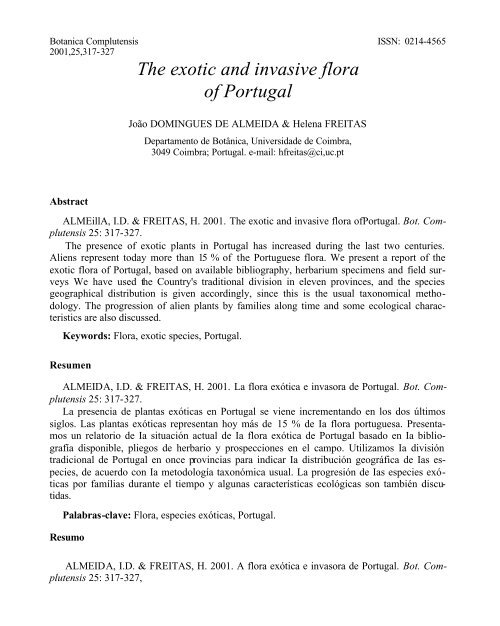
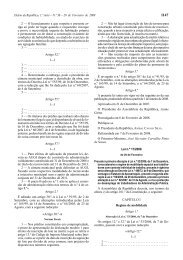
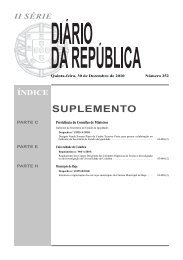
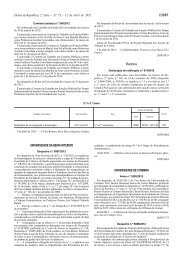
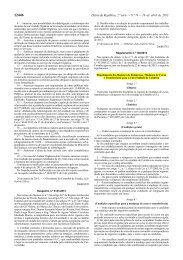
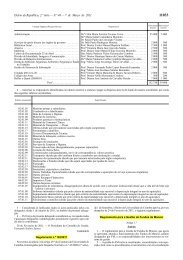
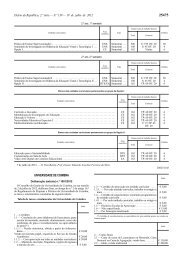
![RL #35 [quadrimestral. Julho 2012] - Universidade de Coimbra](https://img.yumpu.com/27430063/1/190x234/rl-35-quadrimestral-julho-2012-universidade-de-coimbra.jpg?quality=85)
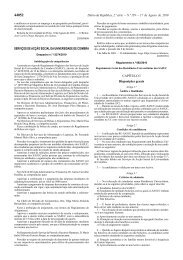
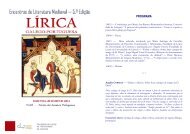
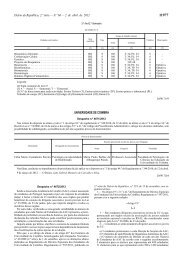
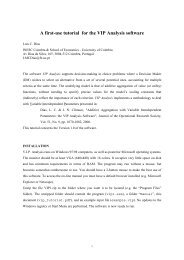
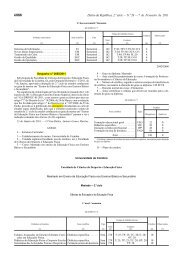

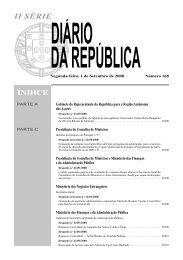
![RL #34 [quadrimestral. Março 2012] - Universidade de Coimbra](https://img.yumpu.com/27430022/1/190x234/rl-34-quadrimestral-marao-2012-universidade-de-coimbra.jpg?quality=85)